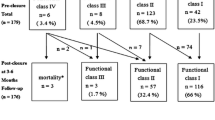Abstract
Background
Interventional closure of atrial septal defects (ASD) has become a standard procedure in pediatric and adult patients. We report immediate and mid-term results in different adult age groups.
Methods
A retrospective analysis of 332 patients undergoing percutaneous ASD closure between 1998 and 2008 was performed. Beside echocardiographic and hemodynamic measurements, the NYHA functional class was assessed before and after ASD closure. The peak oxygen uptake (VO2peak) was available in a subgroup of 154 patients.
Results
The different age groups did not differ significantly in shunt volume or defect diameter, but a significant increase could be detected in mean pulmonary arterial pressure, mean left atrial pressure and pulmonary vascular resistance (PVR9 with increasing age). Right ventricular enlargement was present in all age groups, but the degree of enlargement increased with age. Transcatheter ASD closure was successful in 99.4%, major adverse events occurred in four patients (1.2%). At 3 months from closure, 123 patients reported an improvement, 7 of worsening and 163 of no change in their functional capacity. A significant increase in VO2peak could be registered in all subgroups after ASD closure. When classified by shunt volume no change could be detected in VO2peak in the patients with a Q p:Q s < 2, whereas patients with a Q p:Q s > 2 had a highly significant VO2peak increase.
Conclusion
Patients benefit from interventional closure of hemodynamically significant ASD regardless of their age. However, the defect should be repaired as early as possible to prevent hemodynamic complications, such as the development of pulmonary hypertension and cardiac arrhythmias.




Similar content being viewed by others
References
Brochu MC, Baril JF, Dore A, Juneau M, Guise P, Mercier LA (2002) Improvements in exercise capacity in asymptomatic and mildly symptomatic adults after atrial septal defect percutaneous closure. Circulation 106:1821–1826
Campbell M (1970) Natural history of atrial septal defect. Br Heart J 32:820–826
Costache V, Chavanon O, Thony F, Blin D (2005) Aortic arch embolization of an Amplatzer occluder after an atrial septal defect closure: hybrid operative approach without circulatory arrest. Eur J Cardiothorac Surg 28:340–342
Divchev D, Schaefer A, Fuchs M, Breymann T, Drexler H, Meyer GP (2007) Thrombus formation on atrial septal defect closure device: a case report and review of the literature. Eur J Echocardiogr 8:53–56
Du Z, Hijazi ZM, Kleinman CS, Silverman NH, Larntz K (2002) Comparison between transcatheter and surgical closure of secundum atrial septal defect in children and adults. J Am Coll Cardiol 39:1836–1844
Fischer G, Stieh J, Uebing A, Hoffmann U, Morf G, Kramer HH (2003) Experience with transcatheter closure of secundum atrial septal defects using the Amplatzer septal occluder: a single centre study in 236 consecutive patients. Heart 89:199–204
Giardini A, Donti A, Specchia S, Formigari R, Oppido G, Picchio FM (2008) Long-term impact of transcatheter atrial septal defect closure in adults on cardia function and exercise capacity. Int J Cardiol 124:179–182
Giardini A, Donti A, Formigari R, Specchia S, Prandstraller D, Bronzette G, Bonvicini M, Picchio FM (2004) Determinants of cardiopulmonary functional improvement after transcatheter atrial septal defect closure in asymptomatic adults. J Am Coll Cardiol 43:1886–1891
Jategaonkar S, Scholtz W, Schmidt H, Horstkotte D (2009) Percutaneous closure of atrial septal defects: echocardiographic and functional results in elderly patients over 60 years. Circ Cardiovasc Intervent 2:85–89
King TD, Thompson SL, Steiner C, Mills NL (1976) Secundum atrial septal defect Nonoperative closure during cardiac catheterization. JAMA 235:2506–2509
Krumsdorf U, Ostermayer S, Billinger K, Trepels T, Zadan E, Horvath K, Sievert H (2004) Incidence and clinical course of thrombus formation on atrial septal defect and patent foramen devices in 1000 consecutive patients. J Am Coll Cardiol 43:302–309
Masura J, Gavora P, Podnar T (2005) Long-term outcome of transcatheter secundum-type atrial septal defect closure using Amplatzer septal occluders. J Am Coll Cardiol 45:505–507
Samánek M, Slavis Z, Zborilová B, Hrobonová V, Vorisková M, Skovránek J (1989) Prevalence, treatment and outcome of heart disease in live-born children: a prospective analysis of 91, 823 live-born children. Pediatr Cardiol 10:205–211
Spies C, Timmermann I, Schräder R (2007) Transcatheter closure of secundum atrial septal defects in adults with the Amplatzer septal occluder: intermediate and long-term results. Clin Res Cardiol 96:340–346
Conflict of interest statement
None.
Author information
Authors and Affiliations
Corresponding author
Additional information
Jategaonkar: Interventional closure of ASD.
Rights and permissions
About this article
Cite this article
Jategaonkar, S., Scholtz, W., Schmidt, H. et al. Cardiac remodeling and effects on exercise capacity after interventional closure of atrial septal defects in different adult age groups. Clin Res Cardiol 99, 183–191 (2010). https://doi.org/10.1007/s00392-009-0105-2
Received:
Accepted:
Published:
Issue Date:
DOI: https://doi.org/10.1007/s00392-009-0105-2




